Those with little interest in the drift scene will struggle to connect with the RTR branding covering this Mustang. It’s the name of Vaughn Gittin Junior’s tuning house, a company that arose from his time drifting a Ford Mustang. Competing on the US drift scene, he realised there was a niche to be filled catering to Mustang fans wanting more visual bling, so he duly obliged. A few crazy YouTube clips later and he’s a zillionaire with RTR pumping out kits for Mustangs, F-150s and Rangers too. And what does RTR stand for? It has nothing to do with the old TVNZ show, Ready to Roll, as that’s not something you want to do in your new Mustang. It’s not Ready to Race either, but rather Ready to Rock. The kids will geddit.
Through his success on the drift scene, Gittin Jr formed a partnership with Ford Performance, a relationship resulting in this creation. The Series 1 Mustang GT RTR Powered by Ford Performance, to give it its full name, morphs the regular Fastback into more of a road racer. There’s all manner of RTR branding, the signature upper and lower grilles with those LEDs, extras for the body kit, a Gurney flap on the spoiler and a rear diffuser. There’s also RTR floor mats, puddle lamps, a serialised dash plaque and a certificate of authenticity.
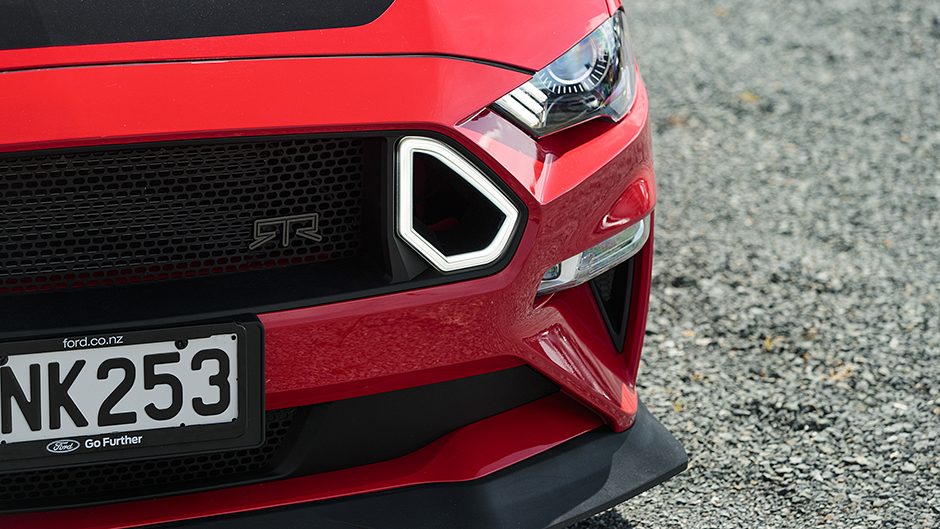
Underneath, it’s fitted with the ‘Track Handling Pack’ from the Ford Performance parts catalogue. This sees new front struts and rear shockers installed while shorter springs chop the ride height by 25mm for that ‘aggressive-looking stance’. Other bits include upper strut mounts, a jounce bumper kit, and adjustable sway bars, rear toe links and knuckle bearings. The kit also works with the optional Magneride shockers if you’re after a more enjoyable everyday ride quality. Also included are hydraulic stays for the bonnet and a strut tower brace.
The tie-up with Ford sees the powertrain remain standard, along with the tyre package, circumventing any need to recal the ESP, though it rolls on different Ford Performance 19-inch alloys.
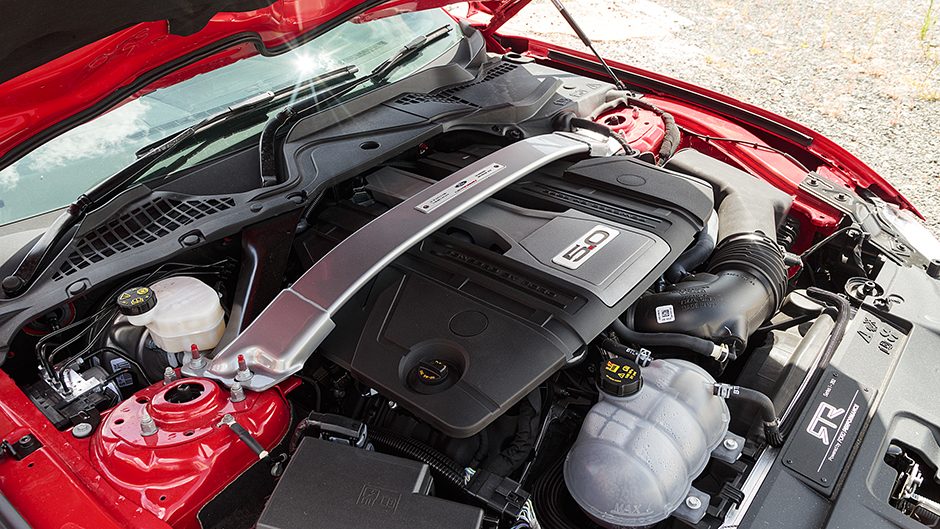
It’s a Ford of America initiative, with a run of 500 cars, 25 of them landing in NZ. By the time you read this, it’s likely those have all gone however. Ford priced them at $89,990, a steal considering you’re getting around $20k worth of bits for a $10k premium over the regular Fastback. As this was dubbed Series 1, there’s a chance there will be another at some point for those who missed the boat.
And it would be worth seeking out as we found this to be a more rounded RTR package than the fully blown Spec 3. The supercharged power dominates proceedings in the latter, bludgeoning the rest of the package into submission. This is a more harmonious, all-rounder type deal. And you still get race car looks and the accompanying stares.
The stock standard Coyote 5.0 is a good V8; the harder you work it, the better it delivers and you can stretch it more often than the charged versions without going supersonic. The real thrust lives beyond 3000rpm, but is delivered in a linear fashion, and the eight sings to seven and bit. With a 10-speed auto behind it, there’s more than enough ratios to get by on. It can swap cogs quickly and does so frequently. Some might find it too busy, but the shift paddles are there for manual control.
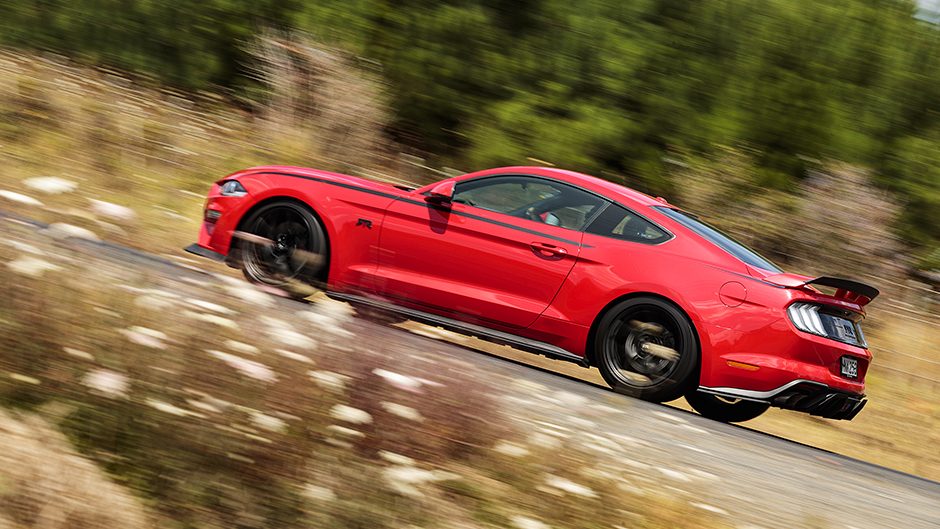
With the handling package underneath, this carries a fierce cornering load. It turns sharply and sticks good, while the roll is negated further. And the rear end feels solidly planted, buried almost. You can get on the gas harder off the curve, the pedal needing a real nudge to upset the rear. The spring package stiffens progress but with Magneride dampers fitted here, the harshness is filtered, while the 19-inch tyres sport a reasonable side wall to help as well. With its lowered ride height, the gnarlier lumps can be a challenge at speed however, bumping the rear about. But this would be a great thing on track, turning better and sticking harder than your stock Mustang.
While we liked the handling, the kids loved the ‘race car’ body kit, and waved to everyone they could on the way to school. Seems not everyone can read the stylised RTR badge though; what’s the GTR bit about, someone asked.
The V8 is always drinking with fuel use rising up to 19L/100km at one stage, but boy does it sound great?
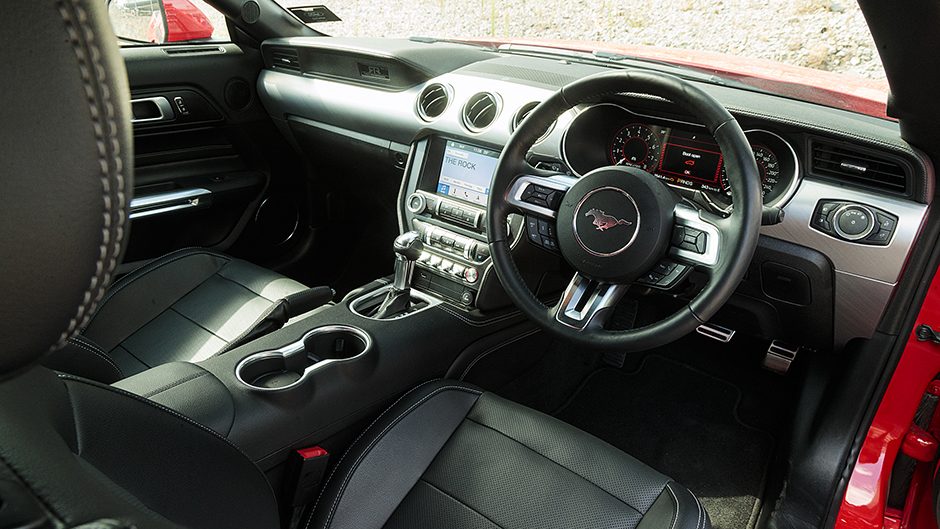
The Mustang has a frustrating drive mode button which has you toggling through the settings in sequential order as the switch only works one way. And there are a tad too many functions in the configurable instruments for the steering wheel buttons to work intuitively. That’s a byproduct of adding technology with the facelift model, but not updating the hardware to suit.
With its lowered stance and its RTR front splitter sticking out, some driveways need a cautious approach, but at least it’s not made of carbon fibre or anything ridiculous, so has some give.
The rocker extensions along the side add to the grounded look, but also make it more of a stretch to get out of the low slung cabin, and you catch the back of your leg on them often when exiting. But such are the sacrifices we make for style. If you don’t care for the look, we’d recommend enquiring about the Ford Performance handling kit at your local dealer to give your S550 Mustang a filip in a dynamic sense.
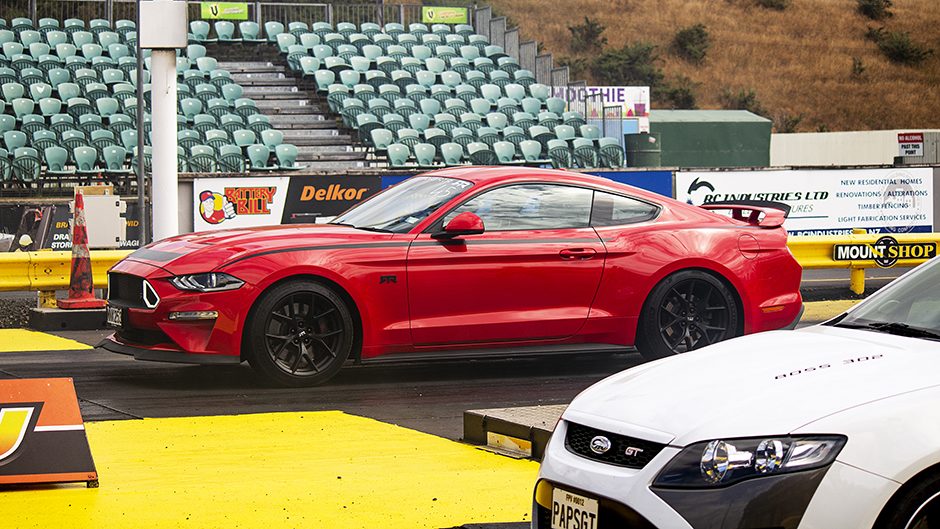
To highlight the breadth of the Mustang’s ability, we took the RTR along for a run down the strip at a private event on Meremere drag way. It was our first time on the strip and an enlightening one. A bit like drifting, drag racing is a tad maligned, not quite mainstream, but it’s been around for yonks. And winning on the strip helped sell muscle cars like the Mustang in their heyday. You might think it boring if you’re more into circuit racing and track days but on the contrary, it’s great fun.
On the day there were all sorts in attendance, muscle cars of all eras and origins, Evos, Audis, Teslas, serious competition cars and even the odd English classic. The kids gave me some sage advice at the start, ‘go fast Dad’, as that’s what it’s all about.
A quick reaction time at the start is key, but it’s harder than it seems. Getting staged early helps, inching up to the Christmas tree to illuminate the white lights at the top. That hopefully gives you a moment to get set because as soon as both racers are staged, the starter can set the lights off. And they change pretty rapidly, three ambers flashing in quick succession before the green. And you need to be putting the hammer down at least by the time the third amber is lit or risk being left behind. The first run of the day wasn’t flash with a .303 of a second reaction time or R/T as they call it on the strip. We managed to get better, with a few below .100, one red light, and a best of .002. Let’s call that a fluke.
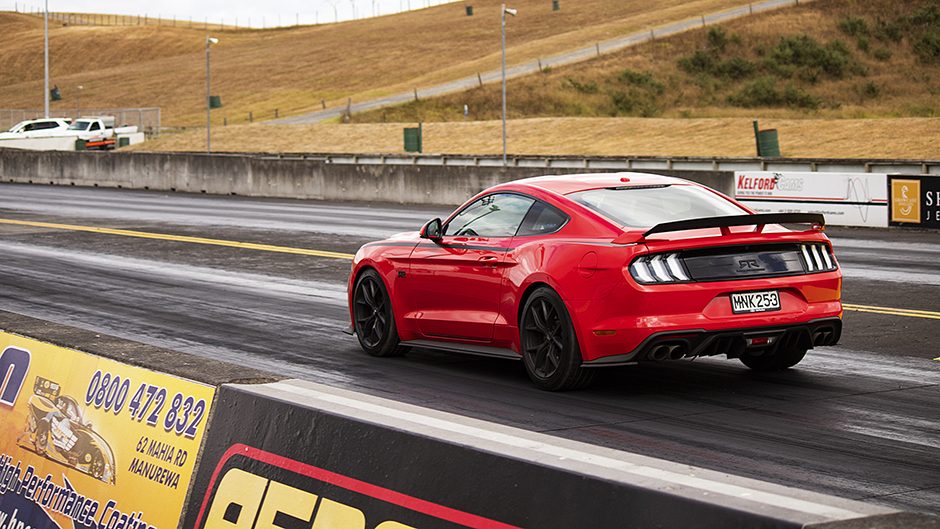
Mustang has a multitude of drive modes now, including a Drag Race setting where the timing isn’t interrupted between shifts, and each cog is swapped hard and fast. For interest’s sake, we did a couple of runs in Sport Plus where the shifts are fast but not so furious, and resulted in times both in the high 12.8sec range. In Drag mode, each change is accompanied by a chirp of the tyres as the torque hits through the driveline, but it helps produce quicker times, our fastest of the day being a 12.714sec. The automatic sure makes life easy; just gun it and hold on. There was only one slight hiccup all day, launching a tad more enthusiastically than usual had the rears scratching harder for traction, the rear end getting a bit of a hop on. It was nothing too major we thought, but it caused a hesitation on the change into second, like it missed a gear, and we found ourselves quickly shunted through to third. Heck, even automatics can miss a gear change under duress. It was time for lunch anyway, so we gave it a rest. After that, it ran again faultlessly a few more times in the afternoon. We turned the traction control off, as we didn’t want it ruining the fun, but left the ESP on as it’s always best to have the safety net in the background should the unthinkable happen.
Of particular note was a match up with a blue 2018 Mustang. Other than the 20-inch wheels it looked fairly standard but it had been enhanced with the big 700hp supercharger.
The owner was wondering what times we’d been getting, thinking we too had the full monte supercharger. They were surprised to find it was running a standard powertrain, but more so to find we were only 0.1sec adrift of their times. But as we have found with the supercharged versions, they struggle to put the power down off the line, and can easily smoke the treads below 100km/h. On the ‘prepped’ staging area, the surface is so tacky your shoes literally stick to it when you walk across it.
And so we had no real issues launching the standard car. With 2000rpm stalled up on the brake, we could get on the gas pretty quickly at the green, the drive hooking up cleanly and the GT powering on. Not so in the bigger horsepower car, the owner saying he needed to ease it in, and couldn’t go full noise until at least quarter track. And with the start won, it’s hard to make up the difference, even with 700hp. It was pretty close, but our #45 car eked out a slender win on both occasions. We chatted about the various drive modes afterwards, debating the merits of each though the conclusion was simple; the blue meanie required more traction. We suggested a set of drag tyres next time. They clearly work as a couple of 11-second supercharged Commodores and Falcons were certainly helped by running a wider drag radial on the rear. Power is useless without traction.
| Model | Ford Mustang Series 1 Fastback GT RTR | Price | $79,990 |
| Engine | 5038cc, V8, DI, 339kW/556Nm | Drivetrain | 10-Speed auto, RWD |
| Fuel Use | 12.1L/100km | C02 Output | 249g/km |
| 0-100km/h | 4.87 sec | Weight | 1776kg |


